Target Information
| Target General Information | Top | |||||
|---|---|---|---|---|---|---|
| Target ID |
T57700
(Former ID: TTDS00270)
|
|||||
| Target Name |
Tyrosine-protein kinase Kit (KIT)
|
|||||
| Synonyms |
v-kit Hardy-Zuckerman 4 feline sarcoma viral oncogene homolog; p145 c-kit; Proto-oncogene tyrosine-protein kinase Kit; Proto-oncogene c-Kit; Piebald trait protein; PBT; Mast/stem cell growth factor receptor Kit; CD117 antigen; CD117; C-kit
Click to Show/Hide
|
|||||
| Gene Name |
KIT
|
|||||
| Target Type |
Successful target
|
[1] | ||||
| Disease | [+] 7 Target-related Diseases | + | ||||
| 1 | Bone/articular cartilage neoplasm [ICD-11: 2F7B] | |||||
| 2 | Colorectal cancer [ICD-11: 2B91] | |||||
| 3 | Gastrointestinal stromal tumour [ICD-11: 2B5B] | |||||
| 4 | Mature B-cell lymphoma [ICD-11: 2A85] | |||||
| 5 | Myeloproliferative neoplasm [ICD-11: 2A20] | |||||
| 6 | Renal cell carcinoma [ICD-11: 2C90] | |||||
| 7 | Thrombocytopenia [ICD-11: 3B64] | |||||
| Function |
In response to KITLG/SCF binding, KIT can activate several signaling pathways. Phosphorylates PIK3R1, PLCG1, SH2B2/APS and CBL. Activates the AKT1 signaling pathway by phosphorylation of PIK3R1, the regulatory subunit of phosphatidylinositol 3-kinase. Activated KIT also transmits signals via GRB2 and activation of RAS, RAF1 and the MAP kinases MAPK1/ERK2 and/or MAPK3/ERK1. Promotes activation of STAT family members STAT1, STAT3, STAT5A and STAT5B. Activation of PLCG1 leads to the production of the cellular signaling molecules diacylglycerol and inositol 1,4,5-trisphosphate. KIT signaling is modulated by protein phosphatases, and by rapid internalization and degradation of the receptor. Activated KIT promotes phosphorylation of the protein phosphatases PTPN6/SHP-1 and PTPRU, and of the transcription factors STAT1, STAT3, STAT5A and STAT5B. Promotes phosphorylation of PIK3R1, CBL, CRK (isoform Crk-II), LYN, MAPK1/ERK2 and/or MAPK3/ERK1, PLCG1, SRC and SHC1. Tyrosine-protein kinase that acts as cell-surface receptor for the cytokine KITLG/SCF and plays an essential role in the regulation of cell survival and proliferation, hematopoiesis, stem cell maintenance, gametogenesis, mast cell development, migration and function, and in melanogenesis.
Click to Show/Hide
|
|||||
| BioChemical Class |
Kinase
|
|||||
| UniProt ID | ||||||
| EC Number |
EC 2.7.10.1
|
|||||
| Sequence |
MRGARGAWDFLCVLLLLLRVQTGSSQPSVSPGEPSPPSIHPGKSDLIVRVGDEIRLLCTD
PGFVKWTFEILDETNENKQNEWITEKAEATNTGKYTCTNKHGLSNSIYVFVRDPAKLFLV DRSLYGKEDNDTLVRCPLTDPEVTNYSLKGCQGKPLPKDLRFIPDPKAGIMIKSVKRAYH RLCLHCSVDQEGKSVLSEKFILKVRPAFKAVPVVSVSKASYLLREGEEFTVTCTIKDVSS SVYSTWKRENSQTKLQEKYNSWHHGDFNYERQATLTISSARVNDSGVFMCYANNTFGSAN VTTTLEVVDKGFINIFPMINTTVFVNDGENVDLIVEYEAFPKPEHQQWIYMNRTFTDKWE DYPKSENESNIRYVSELHLTRLKGTEGGTYTFLVSNSDVNAAIAFNVYVNTKPEILTYDR LVNGMLQCVAAGFPEPTIDWYFCPGTEQRCSASVLPVDVQTLNSSGPPFGKLVVQSSIDS SAFKHNGTVECKAYNDVGKTSAYFNFAFKGNNKEQIHPHTLFTPLLIGFVIVAGMMCIIV MILTYKYLQKPMYEVQWKVVEEINGNNYVYIDPTQLPYDHKWEFPRNRLSFGKTLGAGAF GKVVEATAYGLIKSDAAMTVAVKMLKPSAHLTEREALMSELKVLSYLGNHMNIVNLLGAC TIGGPTLVITEYCCYGDLLNFLRRKRDSFICSKQEDHAEAALYKNLLHSKESSCSDSTNE YMDMKPGVSYVVPTKADKRRSVRIGSYIERDVTPAIMEDDELALDLEDLLSFSYQVAKGM AFLASKNCIHRDLAARNILLTHGRITKICDFGLARDIKNDSNYVVKGNARLPVKWMAPES IFNCVYTFESDVWSYGIFLWELFSLGSSPYPGMPVDSKFYKMIKEGFRMLSPEHAPAEMY DIMKTCWDADPLKRPTFKQIVQLIEKQISESTNHIYSNLANCSPNRQKPVVDHSVRINSV GSTASSSQPLLVHDDV Click to Show/Hide
|
|||||
| 3D Structure | Click to Show 3D Structure of This Target | AlphaFold | ||||
| HIT2.0 ID | T76PKX | |||||
| Drugs and Modes of Action | Top | |||||
|---|---|---|---|---|---|---|
| Approved Drug(s) | [+] 6 Approved Drugs | + | ||||
| 1 | Pazopanib HCl | Drug Info | Approved | Renal cell carcinoma | [6] | |
| 2 | Pexidartinib | Drug Info | Approved | Tenosynovial giant cell tumour | [7] | |
| 3 | Ponatinib | Drug Info | Approved | Acute lymphoblastic leukaemia | [8], [9] | |
| 4 | Regorafenib | Drug Info | Approved | Metastatic colorectal cancer | [9], [10] | |
| 5 | Ripretinib | Drug Info | Approved | Gastrointestinal stromal tumour | [11] | |
| 6 | Romiplostim | Drug Info | Approved | Thrombocytopenia | [12], [13] | |
| Clinical Trial Drug(s) | [+] 6 Clinical Trial Drugs | + | ||||
| 1 | MP470 | Drug Info | Phase 2 | Solid tumour/cancer | [16], [17], [18] | |
| 2 | XL-820 | Drug Info | Phase 2 | Solid tumour/cancer | [19] | |
| 3 | PLX9486 | Drug Info | Phase 1/2 | Gastrointestinal stromal tumour | [21] | |
| 4 | AMG-191 | Drug Info | Phase 1 | Inflammation | [22] | |
| 5 | CART-117 cells | Drug Info | Phase 1 | Myelodysplastic syndrome | [23] | |
| 6 | OSI-930 | Drug Info | Phase 1 | Solid tumour/cancer | [24], [25] | |
| Discontinued Drug(s) | [+] 1 Discontinued Drugs | + | ||||
| 1 | Motesanib | Drug Info | Discontinued in Phase 3 | Non-small-cell lung cancer | [26], [27] | |
| Preclinical Drug(s) | [+] 1 Preclinical Drugs | + | ||||
| 1 | CAR-T cells targeting CD117 | Drug Info | Preclinical | Acute myeloid leukaemia | [28] | |
| Mode of Action | [+] 3 Modes of Action | + | ||||
| Inhibitor | [+] 28 Inhibitor drugs | + | ||||
| 1 | Pazopanib HCl | Drug Info | [6] | |||
| 2 | Pexidartinib | Drug Info | [7] | |||
| 3 | Ripretinib | Drug Info | [11] | |||
| 4 | Romiplostim | Drug Info | [30] | |||
| 5 | XL-820 | Drug Info | [31] | |||
| 6 | PLX9486 | Drug Info | [32] | |||
| 7 | AMG-191 | Drug Info | [33] | |||
| 8 | PMID25656651-Compound-21a | Drug Info | [34] | |||
| 9 | Pyridine derivative 18 | Drug Info | [35] | |||
| 10 | Pyridine derivative 19 | Drug Info | [35] | |||
| 11 | Pyridine derivative 20 | Drug Info | [35] | |||
| 12 | Pyridine derivative 21 | Drug Info | [35] | |||
| 13 | Pyridine derivative 22 | Drug Info | [35] | |||
| 14 | Motesanib | Drug Info | [36], [37], [38] | |||
| 15 | 5,11-Dimethyl-6H-pyrido[4,3-b]carbazol-9-ol | Drug Info | [39] | |||
| 16 | 9-Bromo-5,11-dimethyl-6H-pyrido[4,3-b]carbazole | Drug Info | [39] | |||
| 17 | 9-Methoxy-5,11-dimethyl-6H-pyrido[4,3-b]carbazole | Drug Info | [39] | |||
| 18 | APCK-110 | Drug Info | [40] | |||
| 19 | AST-487 | Drug Info | [41] | |||
| 20 | Bis-(5-hydroxy-1H-indol-2-yl)-methanone | Drug Info | [42] | |||
| 21 | CP-673451 | Drug Info | [43] | |||
| 22 | Ki-20227 | Drug Info | [44] | |||
| 23 | PD-0166326 | Drug Info | [45] | |||
| 24 | PD-0173956 | Drug Info | [45] | |||
| 25 | Phosphonotyrosine | Drug Info | [46] | |||
| 26 | PMID22765894C8h | Drug Info | [47] | |||
| 27 | PMID23521020C7k | Drug Info | [48] | |||
| 28 | WBZ-7 | Drug Info | [40] | |||
| Modulator | [+] 4 Modulator drugs | + | ||||
| 1 | Ponatinib | Drug Info | [29] | |||
| 2 | Regorafenib | Drug Info | [29] | |||
| 3 | MP470 | Drug Info | [17], [18] | |||
| 4 | OSI-930 | Drug Info | [24], [25] | |||
| CAR-T-Cell-Therapy | [+] 2 CAR-T-Cell-Therapy drugs | + | ||||
| 1 | CART-117 cells | Drug Info | [23] | |||
| 2 | CAR-T cells targeting CD117 | Drug Info | [28] | |||
| Cell-based Target Expression Variations | Top | |||||
|---|---|---|---|---|---|---|
| Cell-based Target Expression Variations | ||||||
| Drug Binding Sites of Target | Top | |||||
|---|---|---|---|---|---|---|
| Ligand Name: Sunitinib | Ligand Info | |||||
| Structure Description | KIT kinase domain in complex with sunitinib | PDB:3G0E | ||||
| Method | X-ray diffraction | Resolution | 1.60 Å | Mutation | No | [49] |
| PDB Sequence |
GPTYKYLQKP
551 MYEVQWKVVE561 EINGNNYVYI571 DPTQLPYDHK581 WEFPRNRLSF591 GKTLGAGAFG 601 KVVEATAYGL611 IKSDAAMTVA621 VKMLKPSAHL631 TEREALMSEL641 KVLSYLGNHM 651 NIVNLLGACT661 IGGPTLVITE671 YCCYGDLLNF681 LRRKRDSFIC691 SKTSPAIMED 759 DELALDLEDL769 LSFSYQVAKG779 MAFLASKNCI789 HRDLAARNIL799 LTHGRITKIC 809 DFGLARDIKN819 DSNYVVKGNA829 RLPVKWMAPE839 SIFNCVYTFE849 SDVWSYGIFL 859 WELFSLGSSP869 YPGMPVDSKF879 YKMIKEGFRM889 LSPEHAPAEM899 YDIMKTCWDA 909 DPLKRPTFKQ919 IVQLIEKQIS929 ES
|
|||||
|
|
LYS593
4.447
LEU595
3.252
GLY596
4.884
VAL603
3.499
ALA621
3.365
LYS623
4.151
VAL654
3.926
THR670
3.324
GLU671
2.979
TYR672
3.555
|
|||||
| Click to View More Binding Site Information of This Target and Ligand Pair | ||||||
| Ligand Name: Pexidartinib | Ligand Info | |||||
| Structure Description | Crystal structure of KIT kinase domain with a small molecule inhibitor, PLX3397 | PDB:7KHG | ||||
| Method | X-ray diffraction | Resolution | 2.15 Å | Mutation | No | [50] |
| PDB Sequence |
HHHMPMYEVQ
556 WKVVEESNGN566 NYSYIDPTQL576 PYDHKWEFPR586 NRLSFGKTLG596 AGAFGKVVEA 606 TAQGLIKSDA616 AMTVAVKMLK626 PSAHSTEREA636 LMSELKVLSY646 LGNHENIVNL 656 LGACTHGGPT666 LVITEYCCYG676 DLLNFLRRKR686 DSFHSSDTSP754 ASMEDDENAL 764 DLEDLLSFSY774 QVAKGMAFLA784 SKNCIHRDLA794 ARNILLTHGR804 ITKICDFGLA 814 RDIKNDSNYV824 DKGNARLPVK834 WMAPESIFNS844 VYTFESDVWS854 YGIFLWELFS 864 LGSSPYPGMP874 VDSKFYKMIK884 EGFRMSSPEH894 APAEMYDIMK904 TCWDADPDKR 914 PTFKQIVQDI924 EKQISES
|
|||||
|
|
TRP557
3.193
LEU595
3.843
VAL603
3.843
ALA621
3.442
LYS623
3.698
GLU640
3.020
LEU644
3.993
LEU647
4.326
ILE653
3.286
VAL654
3.625
THR670
3.568
GLU671
2.872
|
|||||
| Click to View More Binding Site Information of This Target with Different Ligands | ||||||
| Different Human System Profiles of Target | Top |
|---|---|
|
Human Similarity Proteins
of target is determined by comparing the sequence similarity of all human proteins with the target based on BLAST. The similarity proteins for a target are defined as the proteins with E-value < 0.005 and outside the protein families of the target.
A target that has fewer human similarity proteins outside its family is commonly regarded to possess a greater capacity to avoid undesired interactions and thus increase the possibility of finding successful drugs
(Brief Bioinform, 21: 649-662, 2020).
Human Tissue Distribution
of target is determined from a proteomics study that quantified more than 12,000 genes across 32 normal human tissues. Tissue Specificity (TS) score was used to define the enrichment of target across tissues.
The distribution of targets among different tissues or organs need to be taken into consideration when assessing the target druggability, as it is generally accepted that the wider the target distribution, the greater the concern over potential adverse effects
(Nat Rev Drug Discov, 20: 64-81, 2021).
Human Pathway Affiliation
of target is determined by the life-essential pathways provided on KEGG database. The target-affiliated pathways were defined based on the following two criteria (a) the pathways of the studied target should be life-essential for both healthy individuals and patients, and (b) the studied target should occupy an upstream position in the pathways and therefore had the ability to regulate biological function.
Targets involved in a fewer pathways have greater likelihood to be successfully developed, while those associated with more human pathways increase the chance of undesirable interferences with other human processes
(Pharmacol Rev, 58: 259-279, 2006).
Biological Network Descriptors
of target is determined based on a human protein-protein interactions (PPI) network consisting of 9,309 proteins and 52,713 PPIs, which were with a high confidence score of ≥ 0.95 collected from STRING database.
The network properties of targets based on protein-protein interactions (PPIs) have been widely adopted for the assessment of target’s druggability. Proteins with high node degree tend to have a high impact on network function through multiple interactions, while proteins with high betweenness centrality are regarded to be central for communication in interaction networks and regulate the flow of signaling information
(Front Pharmacol, 9, 1245, 2018;
Curr Opin Struct Biol. 44:134-142, 2017).
Human Similarity Proteins
Human Tissue Distribution
Human Pathway Affiliation
Biological Network Descriptors
|
|
|
Note:
If a protein has TS (tissue specficity) scores at least in one tissue >= 2.5, this protein is called tissue-enriched (including tissue-enriched-but-not-specific and tissue-specific). In the plots, the vertical lines are at thresholds 2.5 and 4.
|
| KEGG Pathway | Pathway ID | Affiliated Target | Pathway Map |
|---|---|---|---|
| MAPK signaling pathway | hsa04010 | Affiliated Target |
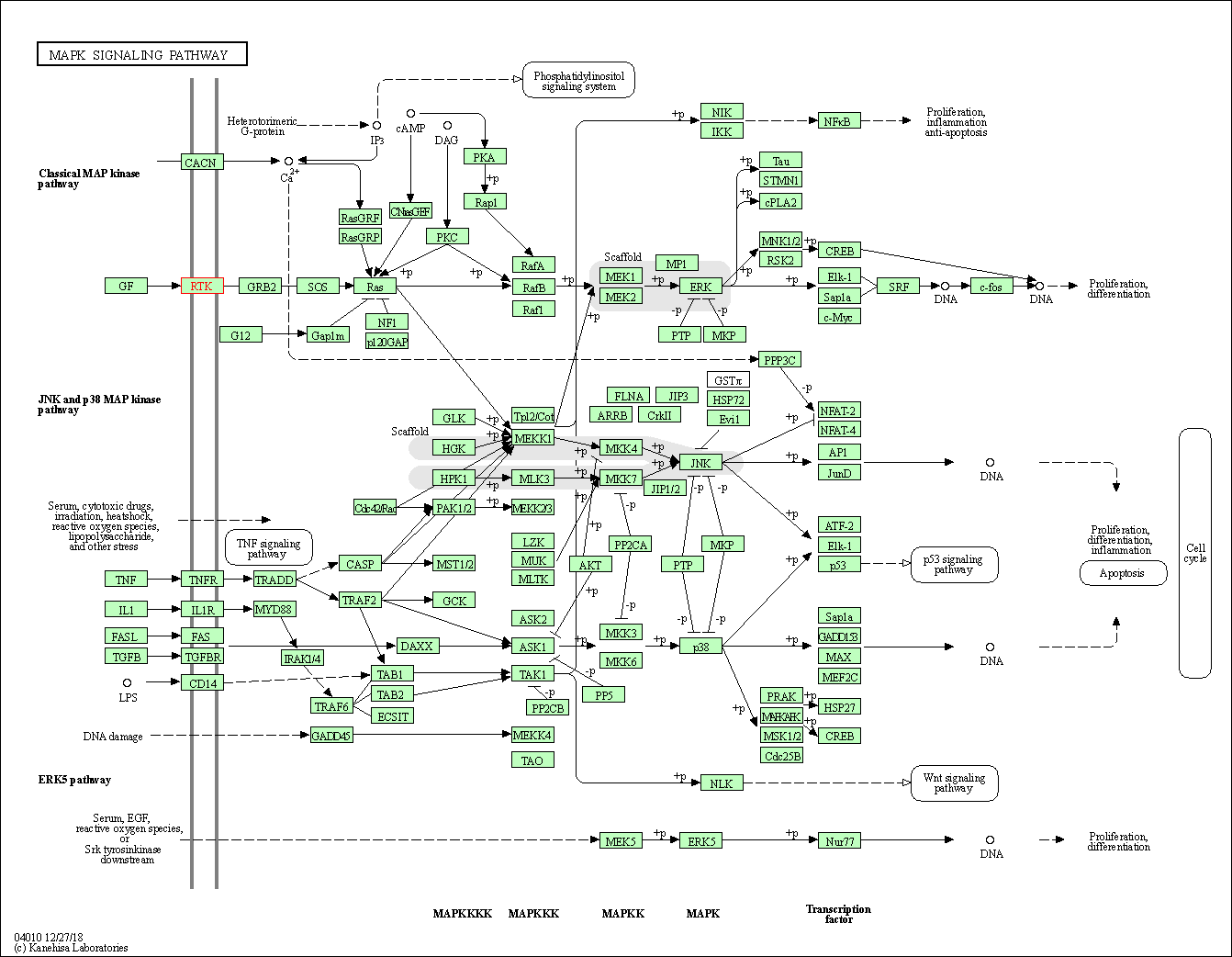
|
| Class: Environmental Information Processing => Signal transduction | Pathway Hierarchy | ||
| Ras signaling pathway | hsa04014 | Affiliated Target |
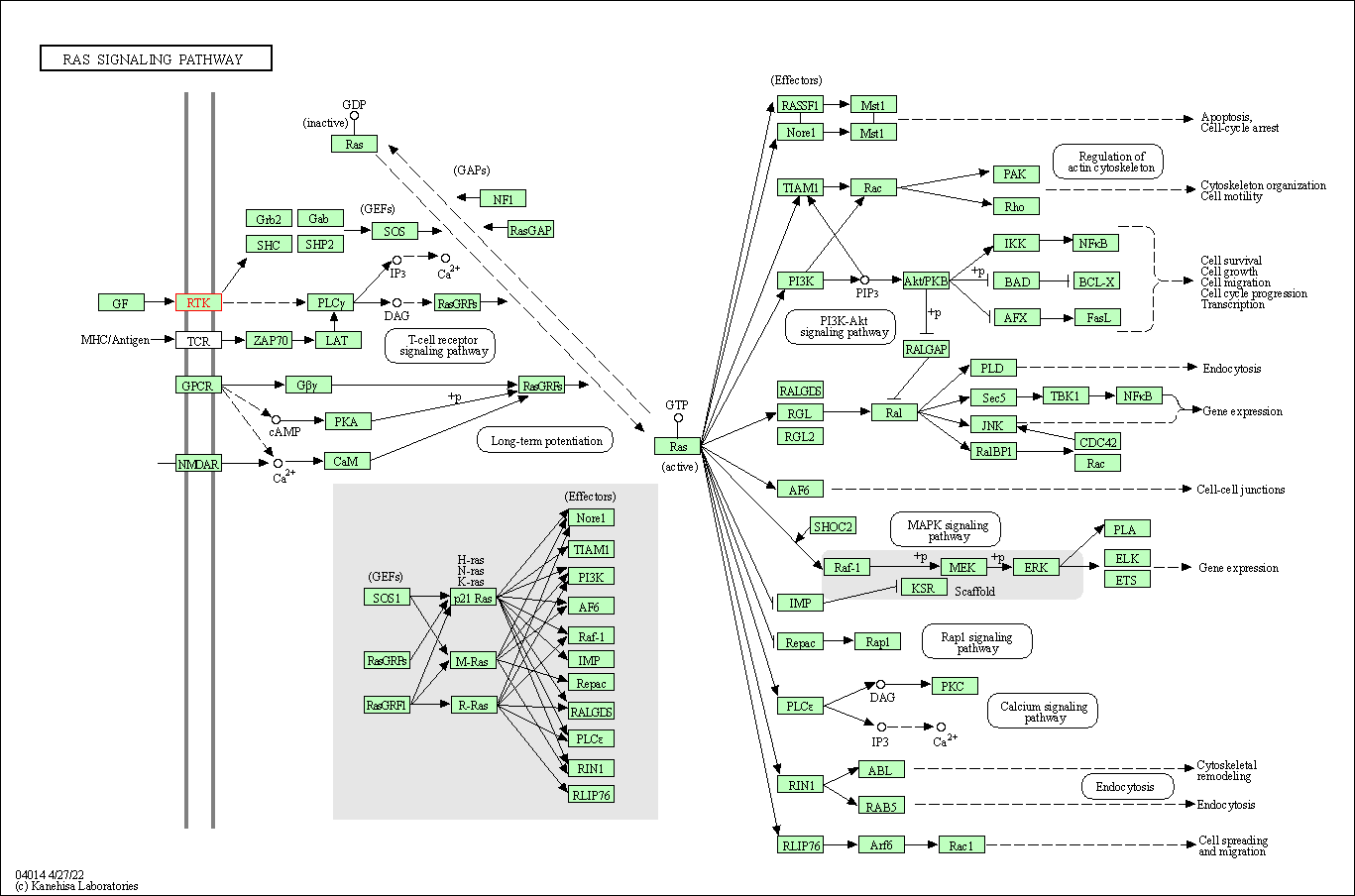
|
| Class: Environmental Information Processing => Signal transduction | Pathway Hierarchy | ||
| Rap1 signaling pathway | hsa04015 | Affiliated Target |
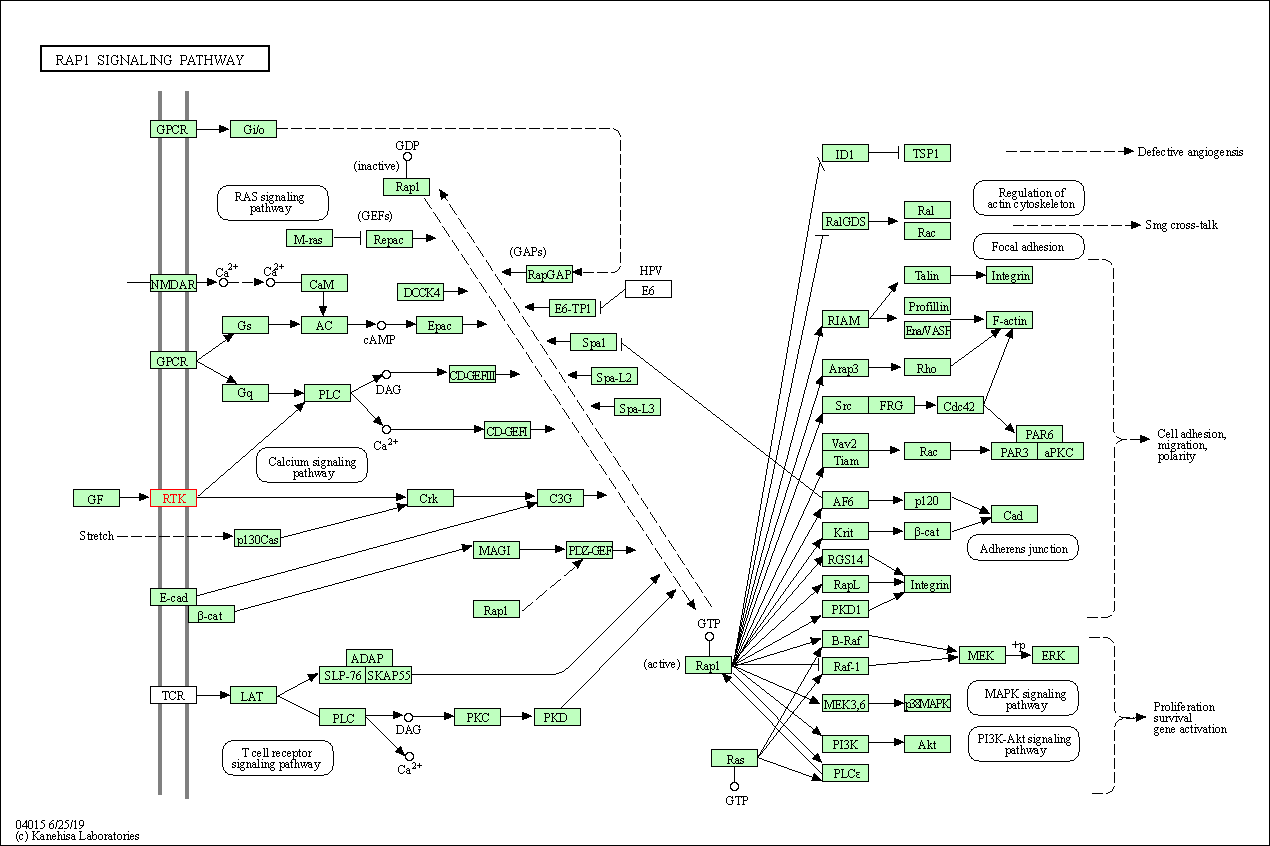
|
| Class: Environmental Information Processing => Signal transduction | Pathway Hierarchy | ||
| Phospholipase D signaling pathway | hsa04072 | Affiliated Target |
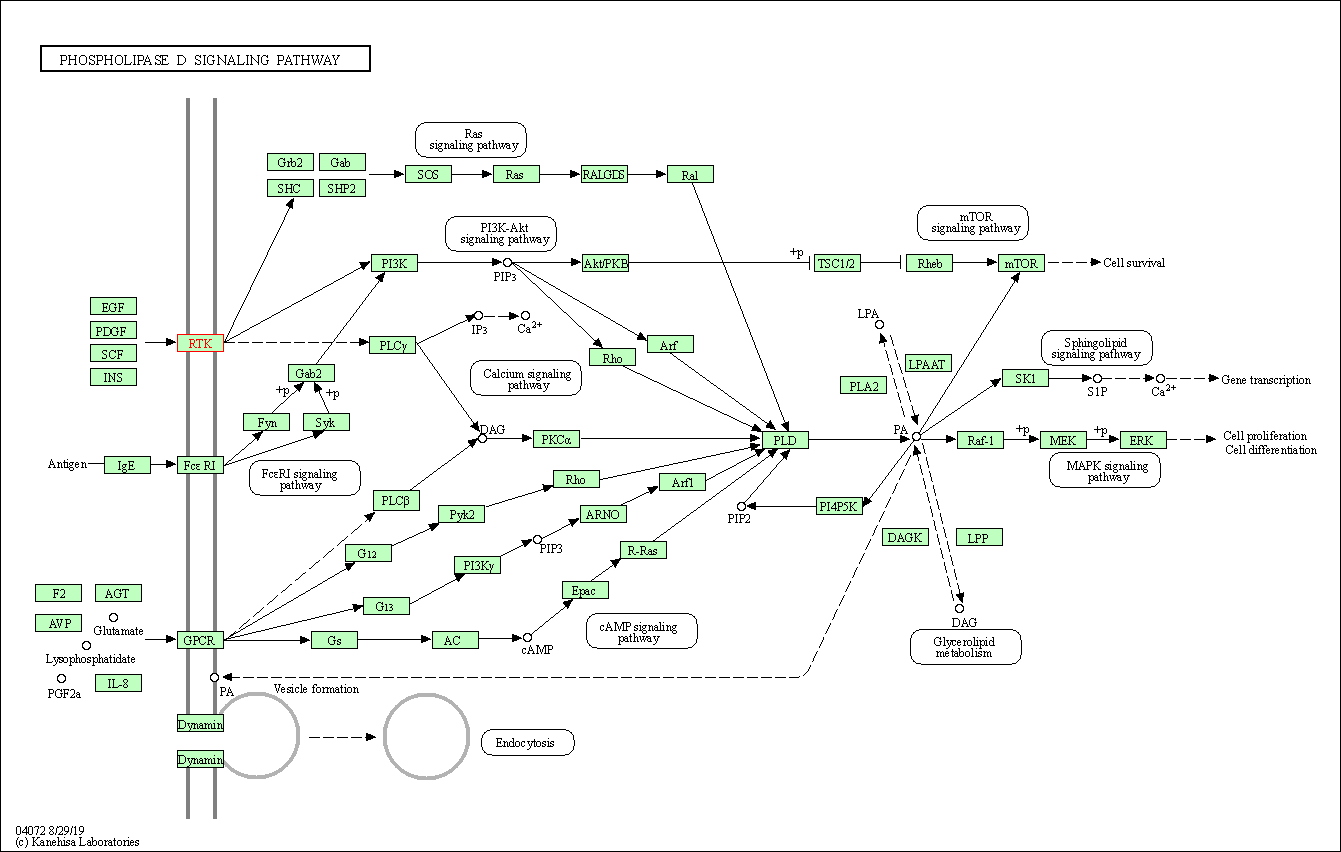
|
| Class: Environmental Information Processing => Signal transduction | Pathway Hierarchy | ||
| PI3K-Akt signaling pathway | hsa04151 | Affiliated Target |
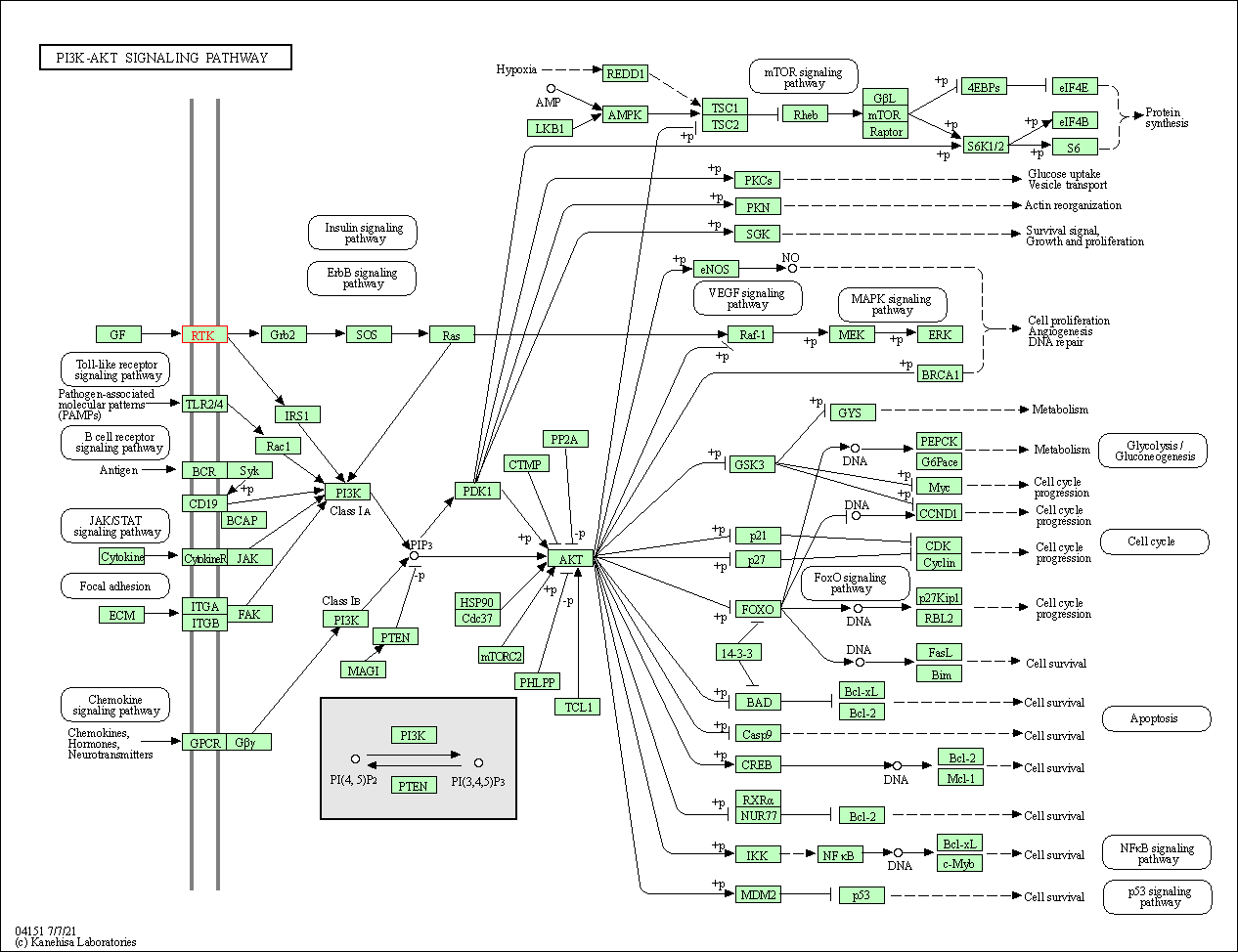
|
| Class: Environmental Information Processing => Signal transduction | Pathway Hierarchy | ||
| Hematopoietic cell lineage | hsa04640 | Affiliated Target |
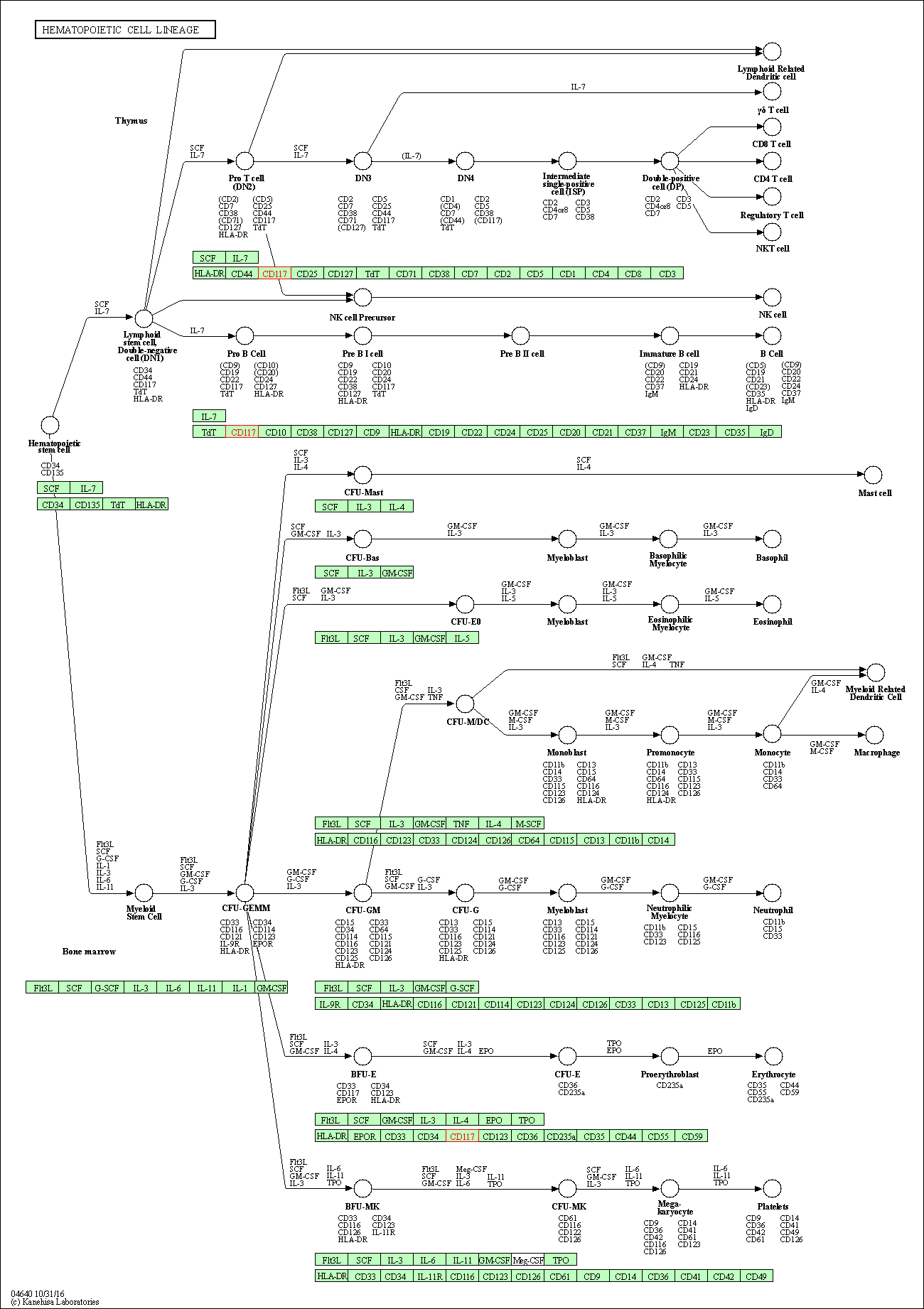
|
| Class: Organismal Systems => Immune system | Pathway Hierarchy | ||
| Melanogenesis | hsa04916 | Affiliated Target |
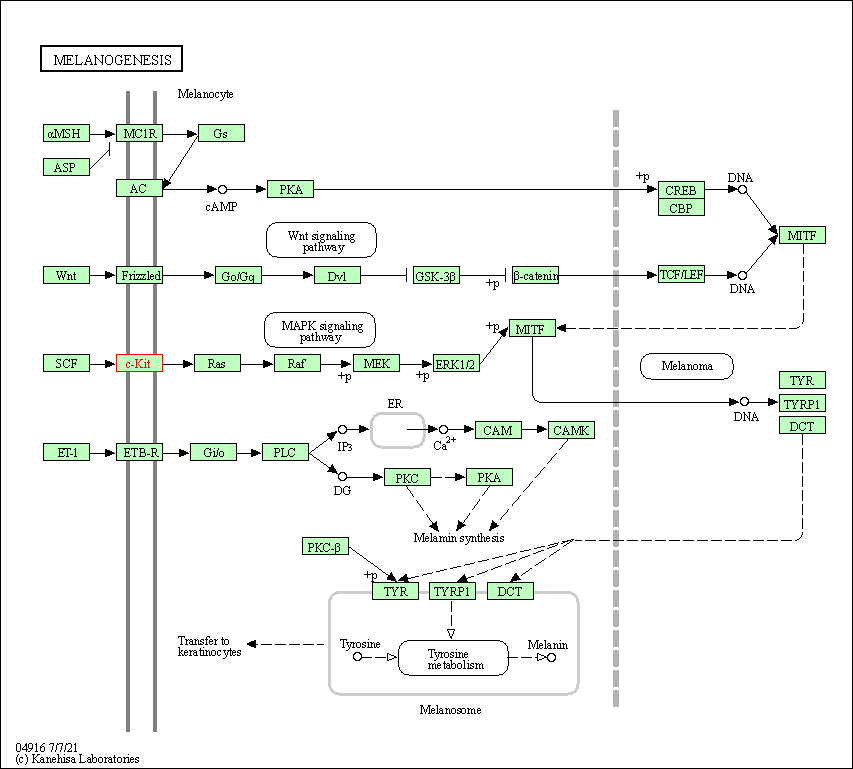
|
| Class: Organismal Systems => Endocrine system | Pathway Hierarchy | ||
| Click to Show/Hide the Information of Affiliated Human Pathways | |||
| Degree | 26 | Degree centrality | 2.79E-03 | Betweenness centrality | 3.85E-04 |
|---|---|---|---|---|---|
| Closeness centrality | 2.38E-01 | Radiality | 1.42E+01 | Clustering coefficient | 3.11E-01 |
| Neighborhood connectivity | 4.73E+01 | Topological coefficient | 1.07E-01 | Eccentricity | 11 |
| Download | Click to Download the Full PPI Network of This Target | ||||
| Chemical Structure based Activity Landscape of Target | Top |
|---|---|
| Drug Property Profile of Target | Top | |
|---|---|---|
| (1) Molecular Weight (mw) based Drug Clustering | (2) Octanol/Water Partition Coefficient (xlogp) based Drug Clustering | |
|
|
||
| (3) Hydrogen Bond Donor Count (hbonddonor) based Drug Clustering | (4) Hydrogen Bond Acceptor Count (hbondacc) based Drug Clustering | |
|
|
||
| (5) Rotatable Bond Count (rotbonds) based Drug Clustering | (6) Topological Polar Surface Area (polararea) based Drug Clustering | |
|
|
||
| "RO5" indicates the cutoff set by lipinski's rule of five; "D123AB" colored in GREEN denotes the no violation of any cutoff in lipinski's rule of five; "D123AB" colored in PURPLE refers to the violation of only one cutoff in lipinski's rule of five; "D123AB" colored in BLACK represents the violation of more than one cutoffs in lipinski's rule of five | ||
| Co-Targets | Top | |||||
|---|---|---|---|---|---|---|
| Co-Targets | ||||||
| Target Poor or Non Binders | Top | |||||
|---|---|---|---|---|---|---|
| Target Poor or Non Binders | ||||||
| Target Regulators | Top | |||||
|---|---|---|---|---|---|---|
| Target-regulating microRNAs | ||||||
| Target-interacting Proteins | ||||||
| Target Profiles in Patients | Top | |||||
|---|---|---|---|---|---|---|
| Target Expression Profile (TEP) | ||||||
| Drug Resistance Mutation (DRM) | ||||||
| Target-Related Models and Studies | Top | |||||
|---|---|---|---|---|---|---|
| Target Validation | ||||||
| References | Top | |||||
|---|---|---|---|---|---|---|
| REF 1 | A comparison of physicochemical property profiles of marketed oral drugs and orally bioavailable anti-cancer protein kinase inhibitors in clinical development. Curr Top Med Chem. 2007;7(14):1408-22. | |||||
| REF 2 | URL: http://www.guidetopharmacology.org Nucleic Acids Res. 2015 Oct 12. pii: gkv1037. The IUPHAR/BPS Guide to PHARMACOLOGY in 2016: towards curated quantitative interactions between 1300 protein targets and 6000 ligands. (Ligand id: 5687). | |||||
| REF 3 | Emerging treatments for pulmonary arterial hypertension. Expert Opin Emerg Drugs. 2006 Nov;11(4):609-19. | |||||
| REF 4 | URL: http://www.guidetopharmacology.org Nucleic Acids Res. 2015 Oct 12. pii: gkv1037. The IUPHAR/BPS Guide to PHARMACOLOGY in 2016: towards curated quantitative interactions between 1300 protein targets and 6000 ligands. (Ligand id: 5711). | |||||
| REF 5 | Sorafenib (BAY 43-9006, Nexavar), a dual-action inhibitor that targets RAF/MEK/ERK pathway in tumor cells and tyrosine kinases VEGFR/PDGFR in tumor vasculature. Methods Enzymol. 2006;407:597-612. | |||||
| REF 6 | Hughes B: 2009 FDA drug approvals. Nat Rev Drug Discov. 2010 Feb;9(2):89-92. | |||||
| REF 7 | Drugs@FDA. U.S. Food and Drug Administration. U.S. Department of Health Human Services. 2019 | |||||
| REF 8 | URL: http://www.guidetopharmacology.org Nucleic Acids Res. 2015 Oct 12. pii: gkv1037. The IUPHAR/BPS Guide to PHARMACOLOGY in 2016: towards curated quantitative interactions between 1300 protein targets and 6000 ligands. (Ligand id: 5890). | |||||
| REF 9 | Nat Rev Drug Discov. 2013 Feb;12(2):87-90. | |||||
| REF 10 | URL: http://www.guidetopharmacology.org Nucleic Acids Res. 2015 Oct 12. pii: gkv1037. The IUPHAR/BPS Guide to PHARMACOLOGY in 2016: towards curated quantitative interactions between 1300 protein targets and 6000 ligands. (Ligand id: 5891). | |||||
| REF 11 | Drugs@FDA. U.S. Food and Drug Administration. U.S. Department of Health Human Services. 2020 | |||||
| REF 12 | URL: http://www.guidetopharmacology.org Nucleic Acids Res. 2015 Oct 12. pii: gkv1037. The IUPHAR/BPS Guide to PHARMACOLOGY in 2016: towards curated quantitative interactions between 1300 protein targets and 6000 ligands. (Ligand id: 6974). | |||||
| REF 13 | 2008 FDA drug approvals. Nat Rev Drug Discov. 2009 Feb;8(2):93-6. | |||||
| REF 14 | URL: http://www.guidetopharmacology.org Nucleic Acids Res. 2015 Oct 12. pii: gkv1037. The IUPHAR/BPS Guide to PHARMACOLOGY in 2016: towards curated quantitative interactions between 1300 protein targets and 6000 ligands. (Ligand id: 7886). | |||||
| REF 15 | Metabolism and bioactivation of famitinib, a novel inhibitor of receptor tyrosine kinase, in cancer patients. Br J Pharmacol. 2013 Apr;168(7):1687-706. | |||||
| REF 16 | URL: http://www.guidetopharmacology.org Nucleic Acids Res. 2015 Oct 12. pii: gkv1037. The IUPHAR/BPS Guide to PHARMACOLOGY in 2016: towards curated quantitative interactions between 1300 protein targets and 6000 ligands. (Ligand id: 7932). | |||||
| REF 17 | Phase 1B study of amuvatinib in combination with five standard cancer therapies in adults with advanced solid tumors. Cancer Chemother Pharmacol. 2014 Jul;74(1):195-204. | |||||
| REF 18 | The receptor tyrosine kinase inhibitor amuvatinib (MP470) sensitizes tumor cells to radio- and chemo-therapies in part by inhibiting homologous recombination. Radiother Oncol. 2011 Oct;101(1):59-65. | |||||
| REF 19 | ClinicalTrials.gov (NCT00570635) A Phase 2 Study of XL820 in Adults With Advanced GIST Resistant to Imatinib and/or Sunitinib. U.S. National Institutes of Health. | |||||
| REF 20 | ClinicalTrials.gov (NCT05357482) Addition of JSP191 (C-kit Antibody) to Non-myeloablative Hematopoietic Cell Transplantation For Sickle Cell Disease and Beta-Thalassemia. U.S.National Institutes of Health. | |||||
| REF 21 | ClinicalTrials.gov (NCT02401815) CGT9486 (Formerly Known as PLX9486) as a Single Agent and in Combination With PLX3397 (Pexidartinib) or Sunitinib in Participants With Advanced Solid Tumors. U.S. National Institutes of Health. | |||||
| REF 22 | Trusted, scientifically sound profiles of drug programs, clinical trials, safety reports, and company deals, written by scientists. Springer. 2015. Adis Insight (drug id 800029529) | |||||
| REF 23 | ClinicalTrials.gov (NCT03291444) CAR-T Cells Combined With Peptide Specific Dendritic Cell in Relapsed/Refractory Leukemia/MDS | |||||
| REF 24 | OSI-930 analogues as novel reversal agents for ABCG2-mediated multidrug resistance. Biochem Pharmacol. 2012 Sep 15;84(6):766-74. | |||||
| REF 25 | Inhibition of c-Kit, VEGFR-2 (KDR), and ABCG2 by analogues of OSI-930. Bioorg Med Chem Lett. 2011 Nov 1;21(21):6495-9. | |||||
| REF 26 | URL: http://www.guidetopharmacology.org Nucleic Acids Res. 2015 Oct 12. pii: gkv1037. The IUPHAR/BPS Guide to PHARMACOLOGY in 2016: towards curated quantitative interactions between 1300 protein targets and 6000 ligands. (Ligand id: 5660). | |||||
| REF 27 | Trusted, scientifically sound profiles of drug programs, clinical trials, safety reports, and company deals, written by scientists. Springer. 2015. Adis Insight (drug id 800011016) | |||||
| REF 28 | ClinicalTrials.gov (NCT03473457) CAR-T Cells Therapy in Relapsed/Refractory Acute Myeloid Leukemia | |||||
| REF 29 | Drugs@FDA. U.S. Food and Drug Administration. U.S. Department of Health & Human Services. 2015 | |||||
| REF 30 | New anilinophthalazines as potent and orally well absorbed inhibitors of the VEGF receptor tyrosine kinases useful as antagonists of tumor-driven a... J Med Chem. 2000 Jun 15;43(12):2310-23. | |||||
| REF 31 | National Cancer Institute Drug Dictionary (drug id 452042). | |||||
| REF 32 | Clinical pipeline report, company report or official report of the Pharmaceutical Research and Manufacturers of America (PhRMA) | |||||
| REF 33 | Trusted, scientifically sound profiles of drug programs, clinical trials, safety reports, and company deals, written by scientists. Springer. 2015. Adis Insight (drug id 800029529) | |||||
| REF 34 | Bcr-Abl tyrosine kinase inhibitors: a patent review.Expert Opin Ther Pat. 2015 Apr;25(4):397-412. | |||||
| REF 35 | RET kinase inhibitors: a review of recent patents (2012-2015).Expert Opin Ther Pat. 2017 Jan;27(1):91-99. | |||||
| REF 36 | Clinical pipeline report, company report or official report of Amgen (2009). | |||||
| REF 37 | Phase II study of safety and efficacy of motesanib in patients with progressive or symptomatic, advanced or metastatic medullary thyroid cancer. J Clin Oncol. 2009 Aug 10;27(23):3794-801. | |||||
| REF 38 | Axitinib for renal cell carcinoma. Expert Opin Investig Drugs. 2008 May;17(5):741-8. | |||||
| REF 39 | Molecular modeling of wild-type and D816V c-Kit inhibition based on ATP-competitive binding of ellipticine derivatives to tyrosine kinases. J Med Chem. 2005 Oct 6;48(20):6194-201. | |||||
| REF 40 | URL: http://www.guidetopharmacology.org Nucleic Acids Res. 2015 Oct 12. pii: gkv1037. The IUPHAR/BPS Guide to PHARMACOLOGY in 2016: towards curated quantitative interactions between 1300 protein targets and 6000 ligands. (Target id: 1805). | |||||
| REF 41 | The RET kinase inhibitor NVP-AST487 blocks growth and calcitonin gene expression through distinct mechanisms in medullary thyroid cancer cells. Cancer Res. 2007 Jul 15;67(14):6956-64. | |||||
| REF 42 | Novel bis(1H-indol-2-yl)methanones as potent inhibitors of FLT3 and platelet-derived growth factor receptor tyrosine kinase. J Med Chem. 2006 Jun 1;49(11):3101-15. | |||||
| REF 43 | Antiangiogenic and antitumor activity of a selective PDGFR tyrosine kinase inhibitor, CP-673,451. Cancer Res. 2005 Feb 1;65(3):957-66. | |||||
| REF 44 | A c-fms tyrosine kinase inhibitor, Ki20227, suppresses osteoclast differentiation and osteolytic bone destruction in a bone metastasis model. Mol Cancer Ther. 2006 Nov;5(11):2634-43. | |||||
| REF 45 | Structure-activity relationships of 6-(2,6-dichlorophenyl)-8-methyl-2-(phenylamino)pyrido[2,3-d]pyrimidin-7-ones: toward selective Abl inhibitors. Bioorg Med Chem Lett. 2009 Dec 15;19(24):6872-6. | |||||
| REF 46 | How many drug targets are there Nat Rev Drug Discov. 2006 Dec;5(12):993-6. | |||||
| REF 47 | The design, synthesis, and biological evaluation of potent receptor tyrosine kinase inhibitors. Bioorg Med Chem Lett. 2012 Aug 1;22(15):4979-85. | |||||
| REF 48 | Discovery and optimization of 3-(2-(Pyrazolo[1,5-a]pyrimidin-6-yl)ethynyl)benzamides as novel selective and orally bioavailable discoidin domain receptor 1 (DDR1) inhibitors. J Med Chem. 2013 Apr 25;56(8):3281-95. | |||||
| REF 49 | KIT kinase mutants show unique mechanisms of drug resistance to imatinib and sunitinib in gastrointestinal stromal tumor patients. Proc Natl Acad Sci U S A. 2009 Feb 3;106(5):1542-7. | |||||
| REF 50 | Association of Combination of Conformation-Specific KIT Inhibitors With Clinical Benefit in Patients With Refractory Gastrointestinal Stromal Tumors: A Phase 1b/2a Nonrandomized Clinical Trial. JAMA Oncol. 2021 Sep 1;7(9):1343-1350. | |||||
If You Find Any Error in Data or Bug in Web Service, Please Kindly Report It to Dr. Zhou and Dr. Zhang.

